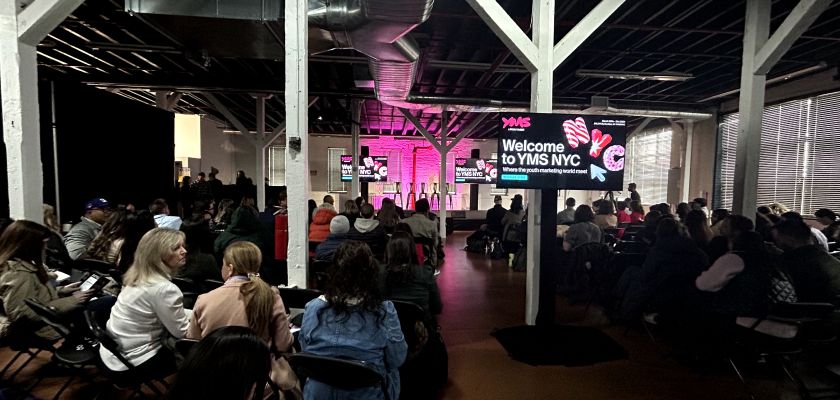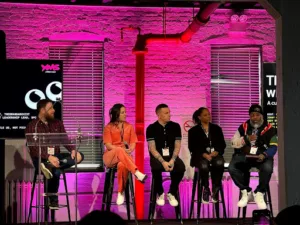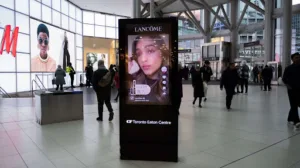
Beyond the Hype: Mastering the Art of Gen Z Marketing
The Youth Marketing Strategy Festival in Brooklyn kicked off with a bang.
Professionals from American agencies, as well as marketers from large brands, shared all their knowledge on Generation Z, how to reach them, and the marketing tools and strategies that are effective with them – a report from the festival by Zsolt Farkas, the CEO of Evolut lifestyle branding agency.

Lots of statistics, specific campaigns, and working methods were presented, and I gathered the most important ones.
The Numbers Don’t Lie
An average Gen Z individual spends 106 days per year on their phone. At first glance, this data is shocking, but from a marketer’s perspective, it’s seen as an opportunity.
Pion, who also organized the conference, conducted a market research study with 2,000 members of the American Gen Z and made the following findings:
Following the statistics, the big guns of the marketing industry took the stage one by one. The first panel featured Jenny Haggard, Global Brand Strategy Lead at Spotify, Andy Kraut from Grindr responsible for sponsorships, Bryan Waddell, Senior Marketing Manager at Nestlé, along with brand strategists Blair Miller and Gary J. Nix to start the first day.
Perhaps the most interesting information came from Jenni Haggard, who revealed that on Spotify, 80 percent of young people listen to podcasts longer than 50 minutes to the end.
This clearly dispels the myth that communication with this generation can only happen in 15-second content snippets. If the storytelling is good and the content interesting, then long content can be particularly effective, regardless of the social platform.
Jenny also shared that Spotify announced a video format on the platform a few weeks ago, positioning itself as a serious competitor to YouTube.

She also talked about how Spotify measures the success of campaigns or activities. According to her, they have serious tools for social listening, and they regularly conduct sentiment analysis to the extent of examining the memes that appear around the subject matter, both their quantity and quality. I haven’t heard of meme analysis in this form before, but if you think about it, it really can be a good indicator of certain trends.
The panel also discussed a generation that is rarely talked about in marketing circles, but which we cannot ignore in a few years. These are the Alphas. The young people born after 2010, who follow Generation Z in sequence.
Surprising statements were made about this age group. For example, they are the least creative, the least active on social media, yet they have the biggest influence on their parents’ purchasing decisions. And let’s pause here for a moment. This is important to emphasize again. The Alpha generation has a significant influence on the purchasing decisions of Generation Y and younger Generation X parents. Therefore, when brands start communicating to these young people in a few years, it should be considered that this will have a big impact on their parents, so the messages and the creative concepts of the campaigns should also be designed with this perspective in mind.
In The Spotlight: Subcultures
Several speakers emphasized the importance of subcultures, noting that members of Generation Z can often only be found in the deepest circles of the internet, within various groups. 54% of young people say that their favorite brands make them feel part of a community.
One speaker, Maxine Gurevich from Horizon Media, mentioned that based on measurements, mass marketing and traditional funnel thinking no longer work. We need to learn to think in terms of subcultures and how to effectively reach them. However, it’s important to note that these niche groups are closely intertwined, so there’s no need to fear that focusing on just one will overly narrow your target audience, as new groups will emerge from that narrow segment due to their close connections. It’s also crucial to have a deep understanding of these subcultures, for which studying Reddit can be an effective method.

Reddit has become a source of under-the-radar information in many countries. People go there to collect “real” information and to write their honest opinions about brands. If you really want to pay attention to your market, then you should also keep an eye on subreddits.
Fluid Funnel
From the speakers’ messages, it’s clear that in America, marketers are no longer thinking in terms of the traditional AIDA (Attention, Interest, Desire, Action) funnel because marketing today flows in a much more fluid, unpredictable yet predictable channel. Why do I say this?
In many cases, truly successful campaigns do not start with scalable marketing activities that then scale up. I’ve often heard that agencies go out to the brand’s stores, work closely with customers, and shape the brand’s social media communication based on feedback. This reminds me of an old saying from when I was active in the venture capital world. I often heard from experienced investors, “do things that don’t scale.” This phrase comes from Paul Graham, the founder of YCombinator, America’s most famous startup incubator.
In his dynamic presentation, Ben Harms, one of the leaders at Archrival agency and former global executive creative director for Tommy Hilfiger, also emphasized this point.
Harms highlighted several key insights:
Less + Bigger = More
In the latter part of the first day, several speakers, including Natalie McGrath, CMO of Rent the Runway, and a marketing leader from Adobe, discussed the importance of not spreading marketing efforts too thin. There should be fewer campaigns, but those should make a big impact. As an example, the marketer from Adobe shared their campaigns, which significantly outperformed the numbers of the company’s performance marketing department in terms of performance and revenue.
One such campaign was their collaboration with Billie Eilish, which reached Generation Z in an unprecedented way through Billie’s follower base. It turned out that Billie uses Adobe Premiere Pro to edit her music videos, making it a natural choice for her to be the face of the brand.
The conference made it clear that in the most advanced market of the marketing profession, the traditional funnel approach has been abandoned, as the purchasing behavior of newer generations (Z and Alpha) does not operate like that of their parents. The traditional model – which suggests that attention must first be captured, then interest generated, followed by awakening desire – needs to be forgotten.
Brands that have recognized the necessity for change are now approaching users in what’s known as an omnipresence strategy. This couldn’t be better illustrated than by the exchange between Geoffrey Goldberg, the leader of the American creative agency Movers & Shakers, and the marketing leader of Essence Cosmetics during a panel discussion.
We, at Evolut also prefer to use the omnipresence strategy in lifestyle branding at our clients. Essentially, it focuses on providing consistent, appealing brand communication across different content and advertising formats with a long-term brand-building goal, rather than achieving immediate sales results. These can include:
A recent great example of this strategy’s application is the beauty brand e.l.f.’s activity around the Super Bowl. The brand, which gained popularity on TikTok, secured America’s most expensive advertising slot for the second year. However, the Super Bowl advertisement was just the tip of the iceberg. The campaign had numerous online and offline activities, installations, and formats that were impossible to miss in the USA. (For those interested in a relevant podcast on this topic, we recommend the Gen Z on Gen Z podcast.)
Be Billboard Famous
Just when one might think there’s no room left for innovation in marketing platforms, along comes Michael Girgis, the founder of DIVE Billboards, to say they’re combining TikTok, giant CLPs, airport and Times Square billboards to connect online and offline presence. Their campaigns deliberately blend the benefits and platforms of the latest social media and traditional media, creating a unique value proposition for brands tired of linear channel communication.
This DOOH (digital-out-of-home) advertising form has 4 key pillars that make such a campaign work:
An excellent example of this is Lancome’s Lash Moment campaign, which combined short TikTok tutorial videos with the screens in malls frequently visited by their target group, thus generating a buying interest where customers can immediately purchase the products.

Pinterest Sticks To What It Does Best
Jeremy Jankowski, Pinterest’s Global Creator Lead, stated that unlike other social channels, Pinterest does not aspire to be more than what it is. This is evident in the market trend where, after platforms ambitiously venture into something entirely new, they generally always return to the format or content type that made them grow.
For instance, Generation Z constitutes 40% of Pinterest’s 1 billion active monthly users, many of whom turn to Pinterest to escape the noise of ads. The platform offers a sort of “safe space” where users can find inspiration on their own without the kind of social pressure present on platforms like TikTok or Instagram.

Interestingly, it was also mentioned that Pinterest prepares an annual trend report attempting to predict upcoming trends based on activity on the platform. They manage to be accurate 87% of the time. Regarding the Barbie movie, Jeremy shared that the Barbie craze started a year before the film’s release, ensuring the hype
Creativity In The Spotlight, Ai In The Background
During the two days of the festival, there wasn’t an excessive focus on artificial intelligence and its use in marketing. At first, this was surprising, but it made complete sense when considering all the information shared.
The only important piece of information about AI worth paying attention to is that a good AI campaign or AI content is one where consumers can’t tell it’s AI.
Since the entry threshold has become extremely low in the fields of image generation, video generation, and text generation, today, it’s no longer impressive to have AI-generated images or Runway-generated AI videos on someone’s social platforms. An average user knows this could be done with a $20 monthly software with the help of a marketing intern.
What’s far more important than AI is the consistent, strong storytelling-based continuous building of the brand. Selecting the right collaborations and brand activities, integrating content creators and influencers into the brand communication in an unforced manner, and finding the right tone on every platform. Producing and distributing high-quality, platform-specific content consistently.
Summary
What worked for Generation Y doesn’t necessarily serve as the foundation for a campaign targeting Generation Z. We need to set aside preconceptions about new social media platforms and truly dive into the depths of Reddit, TikTok, and Pinterest to understand the real problems and behaviors of our market. It is necessary for continuous development, whether we’re on the agency or the client side. Because the market is evolving, with Gen Z marketing upon us, not to mention the Alphas, who will present entirely new challenges to the marketing profession in 3-5 years.
It can be stated that marketing to Generation Z doesn’t necessarily mean using new technologies or AI but involves careful curation and selection of messages, presented in the right packaging.




















